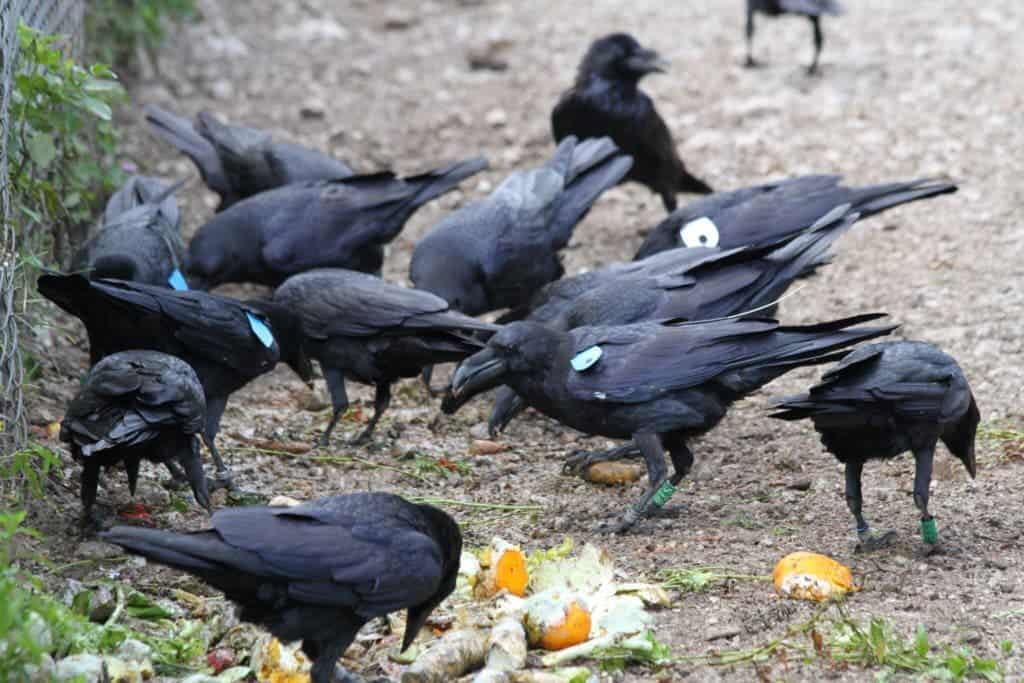Common ravens (Corvus corax) are considered among the most intelligent animals—they can anticipate the future, pull fishing lines out of ice holes, and imitate wolves in order to attract them to break open a tough carcass for them. They also laugh, well, not really, but their foraging call sounds like “haa” and is used to call other ravens to help them forage in dangerous areas. It turns out that this call provides information about the callers’ age and sex, which helps the ravens make the decision whether to come and help or not.
Researchers from the University of Vienna and the University of Cambridge studied wild populations of ravens that gather when the wild boars are fed at the Cumberland Wildpark Grünau, Austria, between the summer of 2009 and the winter of 2010. The wild boars represent possible threats that the ravens need to watch out for. Each feeding session was recording for video and audio. In total, 418 calls made by 12 individuals were recorded and analyzed. The study was published in the open-access journal Frontiers in Zoology.

“Our results suggest that ravens have the necessary variation in their food calls and the cognitive means to distinguish between specific classes of sex and age (class-recognition). Thus, we show for the first time that ravens can potentially use food calls to tell other ravens apart, according to these categories. This gives ravens the opportunity to use information about the caller in decision making processes, such as whether to join or avoid foraging groups,” said Dr. Böckle, research associate in the Department of Psychology at the University of Cambridge.
The frequency, call duration, and amplitude of the calls were different, based on age and sex. Size and hormone levels may cause the calls to sound different. The calling raven uses the call to assemble allies that can help them in a potentially dangerous situation, such as around predators or territorial breeding pairs. The other ravens seem to use this information from the caller to decide whether to join the foraging party. They assess how much competition there is for the food and whether it is worth it for them to join the feeding. They can also judge the strength and reliability of the calling ravens and can reflect whether the interaction is likely to result in aggression and injury. It’s a way to scope the others out.
“Young individuals have a raspier food call than adult ones. Female calls have a higher frequency than males. Typically when a ravens hears a food call emitted by an unknown individual it can decide whether to join or stay away from the foraging situation. Especially adult males are highly dominant and might defend the food resource from younger and unrelated individuals. These fights are potentially lethal and are thus avoided by the subdominant individuals. Young individuals will join other young individuals especially when they are related. Unrelated individuals are hypothesized to decide whether to join or not based on the relative rank of the calling individual,” clarified Dr. Böckle to ZME Science.
The ravens communicate before swooping in to interrupt the boars’ dinner– from the research site. Video credits: Credit: Mario Gallego-Abenza.
Females make the “haa” calls more often than males. In a previous experiment, 90% of ravens responded to females who made the food call. Females are generally lower in social rank, and are therefore not likely to get in fights with higher ranking males. It is a safer bet for males to get an easy food source by joining a female.
“It is important to note that ravens use these calls to primarily refer to food items but at the same time transmit more information than just the presence of food. Calls referring to external objects like food are frequently thought of as precursors of language. Our results add further insights into raven intelligence and their complex feeding behavior,” elaborated Dr. Böckle.
All in all, ravens use their “haa” calls to try to recruit other ravens to create a raven gang, in which they can ward off potential threats due to safety in numbers. What is most important is the information that the call gives about the calling raven, which determines whether others come to help.
Journal reference: Raven food calls indicate sender’s age and sex. Boeckle et al. Frontiers in Zoology 2018.
DOI: 10.1186/s12983-018-0255-z


